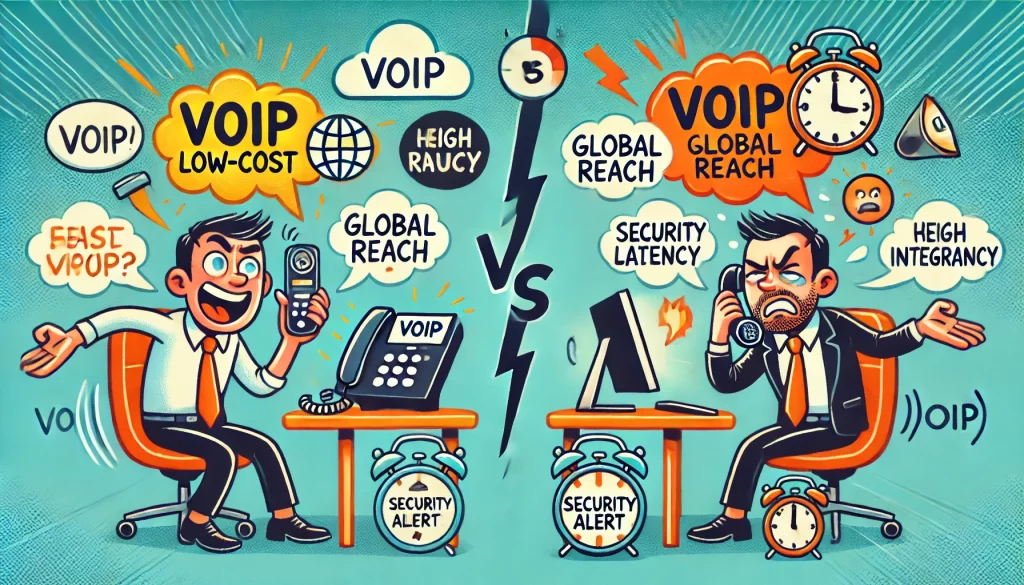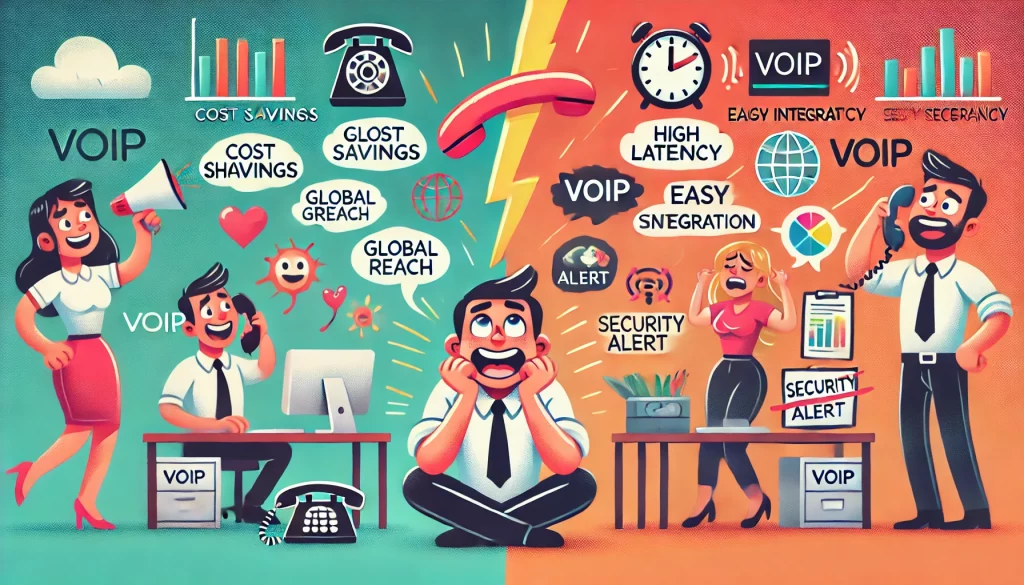VoIP advantages & disadvantages: Improve your communication efficiency

Embracing VoIP: A comprehensive guide for businesses
In the digital era, maintaining effective communication is crucial for business success. While many might think phone calls are obsolete, over 70% of customers still prefer the human touch of speaking directly to businesses over the phone.
Voice over Internet Protocol (VoIP) offers a modern twist to traditional phone systems, combining internet efficiency with the clarity of voice communication. This article delves into the nuances of VoIP, exploring its benefits and challenges to help you make an informed decision for your business.
Understanding VoIP
How VoIP revolutionizes communication
VoIP technology transforms voice into digital signals that can be transmitted over the internet, with services like WhatsApp exemplifying this technology by enabling calls via data connectivity rather than traditional cellular networks. This shift not only enhances flexibility but also broadens accessibility, allowing calls from any location with internet access.
Advantages of VoIP
Cost efficiency
Switching to VoIP can cut communication costs significantly—by more than 50% compared to traditional phone systems. The elimination of PBX systems, which can cost upwards of $2,000 per employee, and reduced hardware needs contribute to substantial savings.
Additionally, VoIP’s compatibility with remote work models can further diminish travel and operational expenses.
Accessibility and scalability
With VoIP, geographical boundaries blur, enabling seamless communication from anywhere. This system adapts easily to business growth, scaling to accommodate increasing calls or expansion without major infrastructure overhauls.
Enhanced communication features
VoIP goes beyond voice calls, incorporating features such as video conferencing, call forwarding, and voicemail-to-email. These capabilities enrich customer interactions and streamline internal communications, potentially boosting customer satisfaction and engagement.
Quality and collaboration
Modern VoIP solutions offer superior call quality essential for clear communication. Advanced features support multimedia sharing and collaboration across global teams, making it invaluable for international operations and remote teamwork.
![]()
Drawbacks of VoIP
Reliance on internet connectivity
VoIP’s performance is heavily dependent on internet quality. A robust, high-speed internet connection is essential, as low bandwidth or high latency can severely impair service quality.
Emergency call limitations
The portable nature of VoIP can complicate emergency service responses due to difficulties in tracking calls. Regular updates to E-911 information are crucial for accurate location tracking.
Hardware compatibility
Some older systems, like alarm systems and fax machines, may face compatibility issues with VoIP. Upgrading or retrofitting may be necessary to maintain functionality.
Power dependence
Unlike traditional phones, VoIP requires continuous power. In areas prone to power outages, backup solutions such as UPS systems or generators are vital to ensure uninterrupted service.
Security vulnerabilities
VoIP systems can be targets for cyber threats, including phishing and malware. Strong security measures, such as encrypted connections and rigorous protocols, are essential to safeguard communications.

Choosing the right VoIP solution
Assessment of needs
Start by evaluating your specific communication requirements—consider factors like call volume, user count, and essential features. Assess whether your workforce is remote and the scalability needed for future growth.
Infrastructure evaluation
Confirm that your internet setup can support VoIP effectively. Testing current bandwidth and upgrading to more robust options like fiber or 5G may be necessary.
Provider comparison
Research VoIP providers thoroughly, focusing on user reviews, security features, and customer support quality. Ensure the pricing aligns with your budget.
Compatibility checks
Review your current hardware for VoIP compatibility. Address any integration issues with existing systems to ensure smooth operation.
Preparation for power issues
Implement backup power solutions to counteract potential power interruptions, securing continuous operation.
Security implementation
Adopt comprehensive security strategies to protect your VoIP system from cyber threats. Regular updates and staff training on security awareness are crucial.
Performance testing
Before a full rollout, conduct a trial run of the VoIP system to evaluate its effectiveness. Monitor and adjust based on user feedback and performance data to optimize the setup.
VoIP stands as a robust solution for modern business communication, merging cost-effectiveness with functional richness. By understanding its full spectrum—from technological benefits to potential challenges—businesses can harness VoIP to enhance their operational efficiency and customer engagement.
![]()
Expert opinions on VoIP technology
Dr. Emily Thompson, Telecommunications Professor at Tech University “VoIP technology has revolutionized the way we communicate, particularly in business settings. The cost savings are significant, as companies can cut their phone bills by more than half. Additionally, the flexibility of VoIP allows employees to make and receive calls from anywhere, which is a game-changer in our increasingly remote work culture. However, it’s not without its challenges. Network reliability and security remain concerns, especially for organizations handling sensitive information. Robust encryption and dedicated IT support are essential to mitigate these risks.”
Michael Harris, CEO of ConnectCorp “As the CEO of a company that has fully transitioned to VoIP, I can attest to the substantial benefits it offers. We have seen a 60% reduction in communication costs and a significant boost in productivity due to features like voicemail-to-email and call forwarding. Our customer service has also improved with the ability to integrate VoIP with our CRM systems. On the downside, we did face initial setup challenges, particularly with ensuring our network could handle the increased data traffic. Investing in high-quality routers and sufficient bandwidth is crucial for a smooth VoIP experience.”
Linda Park, Senior IT Consultant at TechSolutions “VoIP is an excellent solution for businesses looking to modernize their communication infrastructure. The scalability of VoIP systems means they can grow with your business without the need for major hardware investments. Additionally, VoIP offers advanced features that traditional phone systems simply can’t match, such as video conferencing and instant messaging. However, it’s important to conduct a thorough assessment of your current network capabilities before making the switch. Poor network performance can lead to call quality issues, which can be frustrating for users.”

 5 min
5 min 







